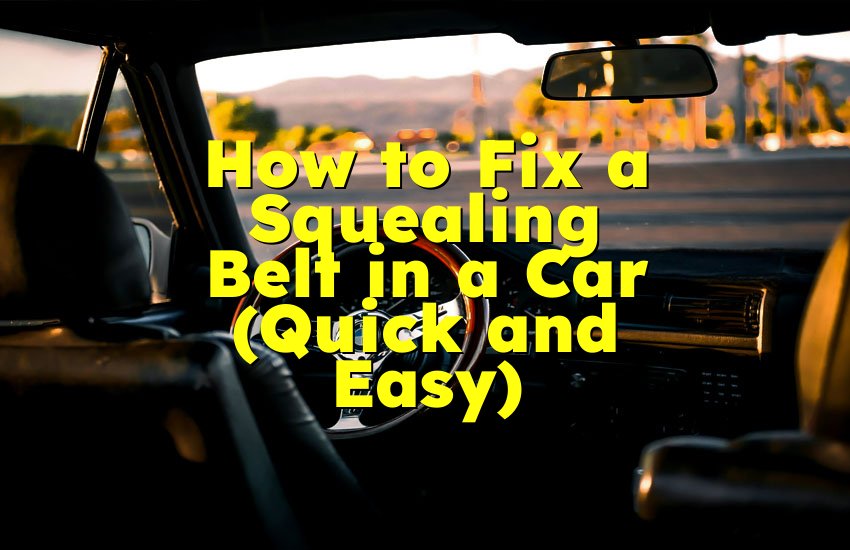As an Amazon Associate, I earn from qualifying purchases at no extra cost to you.
How to Open a Jammed Glove Box: A Simple, Step-by-Step Guide
If you’ve ever struggled with a jammed glove box, you know how frustrating it can be. Whether it's stuck closed, won't open properly, or just doesn't function right, a jammed glove box can really get in the way. But don't worry, in this blog post, we'll show you exactly how to fix it! You'll find simple steps you can follow to get it working again, whether the problem is a simple blockage or something more complicated. Let’s dive into how you can fix your jammed glove box easily and safely.
Common Reasons Why a Glove Box Gets Jammed
Before we get into how to fix a jammed glove box, it's good to know why it happened in the first place. Understanding the problem will help you solve it faster. Here are some of the common reasons why a glove box might get stuck.
Broken or Misaligned Latch Mechanism
The latch on a glove box is the small part that keeps the door closed. If the latch isn't working correctly, the glove box might get stuck. This can happen if the latch breaks, gets bent, or becomes misaligned. When the latch doesn't work right, it can make the glove box hard to open or even impossible to open without forcing it. Sometimes, the latch might just be jammed or stuck in a way that prevents it from unlocking the glove box door.
Objects or Items Blocking the Locking Mechanism
It's easy to forget what's inside the glove box, especially when it's full of papers, pens, snacks, and other small items. But sometimes, things inside can get in the way of the locking mechanism. If there's too much stuff packed in, it might be pressing on the latch or internal parts of the glove box, making it hard to open. Larger items like books or a bag might be pushing against the latch or locking parts, causing the door to become jammed.
Broken Springs or Internal Mechanisms
Inside the glove box, there are small springs and mechanisms that help it open and close smoothly. These springs can break or wear out over time. If the spring that controls the latch breaks, it might not release when you try to open it. The door could become stuck in the closed position or, in some cases, won't stay closed properly once you open it. A broken spring can often be the reason why your glove box stops functioning properly, but it's an easy fix if you know what to look for.
Rust or Dirt Buildup
Over time, dirt, dust, and moisture can build up inside the glove box and around its locking mechanism. This can make it harder for the parts to move smoothly. Rust can also form if moisture gets into the glove box, which can cause the latch and other parts to get stuck. If your glove box hasn't been used in a while, or if you live in a humid area, the internal parts might get dirty or rusted, causing the box to jam. Cleaning and maintaining it regularly can help prevent this issue.
Faulty or Damaged Hinges
Hinges allow the glove box door to open and close smoothly. But like any part of your car, they can wear out over time. If the hinges become damaged, the glove box door might not open properly or might get stuck partway. A broken hinge can also cause the door to become loose, making it hard to keep the glove box shut. When hinges break or get bent, it's a good idea to replace them to avoid further issues.
Step-by-Step Guide to Fixing a Jammed Glove Box
Now that you know the reasons why a glove box gets jammed, let's take a look at how you can fix it. This step-by-step guide will walk you through different ways to open a jammed glove box, depending on what's causing the issue.
Step 1: Check for Blockages Inside the Glove Box
Before trying anything else, you need to see if there are any objects blocking the glove box from opening. Sometimes the problem is as simple as something inside the glove box that's pushing against the latch or lock. Here's how to check:
- Try to open the glove box: First, gently try to open the glove box. If it doesn't open at all or seems stuck, don't force it. Forcing it could break something or make the problem worse.
- Look inside: If you can open the door slightly, take a quick peek inside. Use a flashlight if it's dark in there. See if any objects are blocking the latch or pushing against the internal components.
- Shake the car: If the glove box is too tightly closed for you to see inside, gently shake your car to see if anything shifts inside. This might help free up a stuck item that's blocking the latch.
- Remove any blockages: If you spot anything blocking the lock or latch, carefully remove it. Be careful not to push or pull too hard, as you don't want to damage the internal parts of the glove box.
If you find that the glove box is simply full of things pressing against the latch, removing those items might solve the problem right away.
Step 2: Examine the Latch and Lock Mechanism
If the glove box is still stuck after removing any items inside, the issue might be with the latch itself. The latch mechanism is what keeps the glove box shut, so if it's not working correctly, it could be preventing the door from opening. Here's what you can do:
- Press gently on the latch: Press down on the latch to see if it moves or releases. Sometimes, all it takes is a little extra pressure to get the latch to unlock.
- Look for misalignment: Check the latch for any signs that it might be misaligned or bent. If it looks like it's off-center or crooked, this could be the reason why it's not unlocking.
- Adjust the latch: If the latch seems to be misaligned, you can try to fix it by gently adjusting it back into place. Use a small screwdriver or your fingers to move it into position. Be very careful when doing this, as you don't want to break it or make it worse.
- Test the latch: Once you think the latch is back in place, try opening the glove box again. If it opens, the problem was likely just a misaligned latch. If it still doesn't open, continue with the next step.
Step 3: Clean and Lubricate the Lock Mechanism
If the latch seems fine but the glove box still won't open, there may be dirt, rust, or other buildup inside the mechanism that's causing it to jam. Cleaning the locking mechanism can help make it work smoothly again.
- Use compressed air: If you have a can of compressed air, use it to blow out any dust or dirt from the latch and surrounding areas. This can clear out debris that might be preventing the latch from moving.
- Wipe down the latch: Take a soft cloth and wipe down the latch and any visible parts of the lock mechanism. Make sure you remove any dust or dirt that could be causing the jam.
- Apply lubricant: Use a small amount of lubricant, such as silicone spray or a specialized lock lubricant, and apply it to the latch and locking mechanism. This will help parts move smoothly and reduce the risk of rust.
- Test the latch again: After cleaning and lubricating, try to open the glove box. If it opens, the cleaning and lubrication worked! If not, continue with the next step.
Step 4: Inspect and Fix Broken Springs or Internal Parts
If cleaning and adjusting the latch didn't solve the problem, there could be a broken spring or internal component inside the glove box. This is a more complex issue, but you can still fix it yourself.
- Look for broken springs: If you can access the internal parts of the glove box, check for any springs that might be broken or disconnected. Springs are responsible for helping the glove box open and close smoothly. If one of the springs is broken, it could prevent the glove box from functioning properly.
- Replace the spring: If you find a broken spring, you may need to replace it. You can buy replacement springs at an auto parts store or online. To replace the spring, you'll need to carefully remove the broken one and install the new one in the same position.
- Inspect other internal parts: If the spring isn't the issue, there may be other internal components that are damaged or misaligned. Check for any screws, clips, or plastic parts that might have come loose or broken. Tighten any loose screws, or replace any broken parts with new ones.
- Reassemble and test: After replacing the broken parts, reassemble the glove box and test it. If everything is working correctly, your glove box should open smoothly.
Step 5: Deal with Rust and Corrosion
If your glove box has been exposed to moisture, it's possible that rust has formed on the locking mechanism or other internal parts. Rust can cause parts to stick together, making the glove box difficult or impossible to open. Here's how to fix this:
- Use a rust remover: Buy a rust remover from an auto parts store and carefully apply it to the rusted areas. Follow the product instructions, as different rust removers work in different ways.
- Scrub off the rust: After applying the rust remover, use a soft cloth or brush to scrub away the rust. Be sure to get into all the nooks and crannies where rust might have built up.
- Apply a rust inhibitor: Once the rust is removed, apply a rust inhibitor to prevent future rusting. This will help protect your glove box from moisture and keep it functioning properly.
Step 6: Check the Hinges and Adjust if Necessary
The hinges are another important part of the glove box. If they become loose or damaged, they can prevent the door from opening properly. Here's how to fix this:
- Tighten the hinges: If the hinges are loose, use a screwdriver or wrench to tighten them. This will help ensure the glove box door opens and closes smoothly.
- Replace damaged hinges: If the hinges are broken or severely damaged, you'll need to replace them. You can find replacement hinges at an auto parts store or online. To replace the hinges, remove the broken ones and install the new ones in the same place.
Step 7: Reassemble and Test the Glove Box
Once you've addressed the problem, it's time to put everything back together. Close the glove box and check that everything works as it should. Try opening and closing the door several times to make sure it moves smoothly. If it opens and closes without any issues, you've successfully fixed your jammed glove box!
Tips for Preventing Future Glove Box Jams
Nobody wants to deal with a jammed glove box again. To avoid future issues, here are some tips to keep it working properly:
- Clean it regularly: Regularly clean the glove box to remove dirt and dust that can build up around the latch and locking mechanism.
- Don't overload it: Avoid stuffing too many things inside your glove box. Keeping it organized and not overstuffed will prevent objects from blocking the latch or other parts.
- Check for wear and tear: Periodically check the latch, hinges, and springs for signs of wear. If you notice anything broken or loose, fix it before it becomes a bigger problem.
- Lubricate the latch: Keep the latch well-lubricated to prevent rust and ensure it operates smoothly.
By following these easy steps, you should now be able to open and fix your jammed glove box. Whether it was a simple blockage, a broken spring, or something else, you've got the knowledge to solve the problem. Keep your glove box clean and well-maintained, and you won't have to worry about future jams!
Frequently Asked Questions
Is it safe to try and fix a jammed glove box myself?
It is generally safe to fix a jammed glove box yourself, as long as you follow the proper steps and use the right tools. However, if you feel unsure or encounter complicated issues like broken springs or hinges, it's a good idea to consult a professional mechanic.
Can a jammed glove box cause further damage if not addressed?
Yes, if a jammed glove box is not addressed, it can lead to further damage. For example, forcefully trying to open the glove box without fixing the underlying issue can break the latch, springs, or hinges, which might result in more expensive repairs later on. It's always best to fix it as soon as you notice the problem.
Do I need to replace the entire glove box if the latch is broken?
Not necessarily. In many cases, you can replace just the broken latch or internal components, which can be much cheaper than replacing the entire glove box. However, if the glove box is severely damaged or the latch mechanism is beyond repair, you may need to replace the whole unit.
Can I use any lubricant to fix a jammed glove box?
It's important to use a lubricant that is designed for automotive use. Regular household lubricants might attract dirt or grime, which can make the problem worse over time. Look for a silicone-based lubricant or a product specifically designed for automotive locks and mechanisms.
Is it common for a glove box to get jammed?
It's not uncommon for a glove box to get jammed, especially if it's older or hasn't been maintained properly. Over time, parts like the latch, springs, and hinges can wear out, causing the glove box to become stuck. Regular maintenance and avoiding overloading the glove box can help prevent jams.
Can I open a jammed glove box without any tools?
It depends on the severity of the jam. If the glove box is stuck due to a small blockage or misalignment, you may be able to open it by gently pressing or wiggling the latch. However, for more serious issues like broken springs or hinges, you will need tools to make repairs.
Do I need to take my car to a mechanic to fix a jammed glove box?
In most cases, you can fix a jammed glove box yourself by following the steps outlined in this guide. However, if the issue is complex or involves broken internal components, such as springs or hinges, you may want to consult a professional mechanic to ensure the job is done properly.
Is it possible to prevent a glove box from jamming?
Yes, by regularly cleaning and maintaining your glove box, you can prevent it from jamming. Avoid overstuffing the glove box, and periodically check the latch, hinges, and locking mechanism for signs of wear and tear. This will help keep it functioning smoothly and reduce the risk of future jams.











